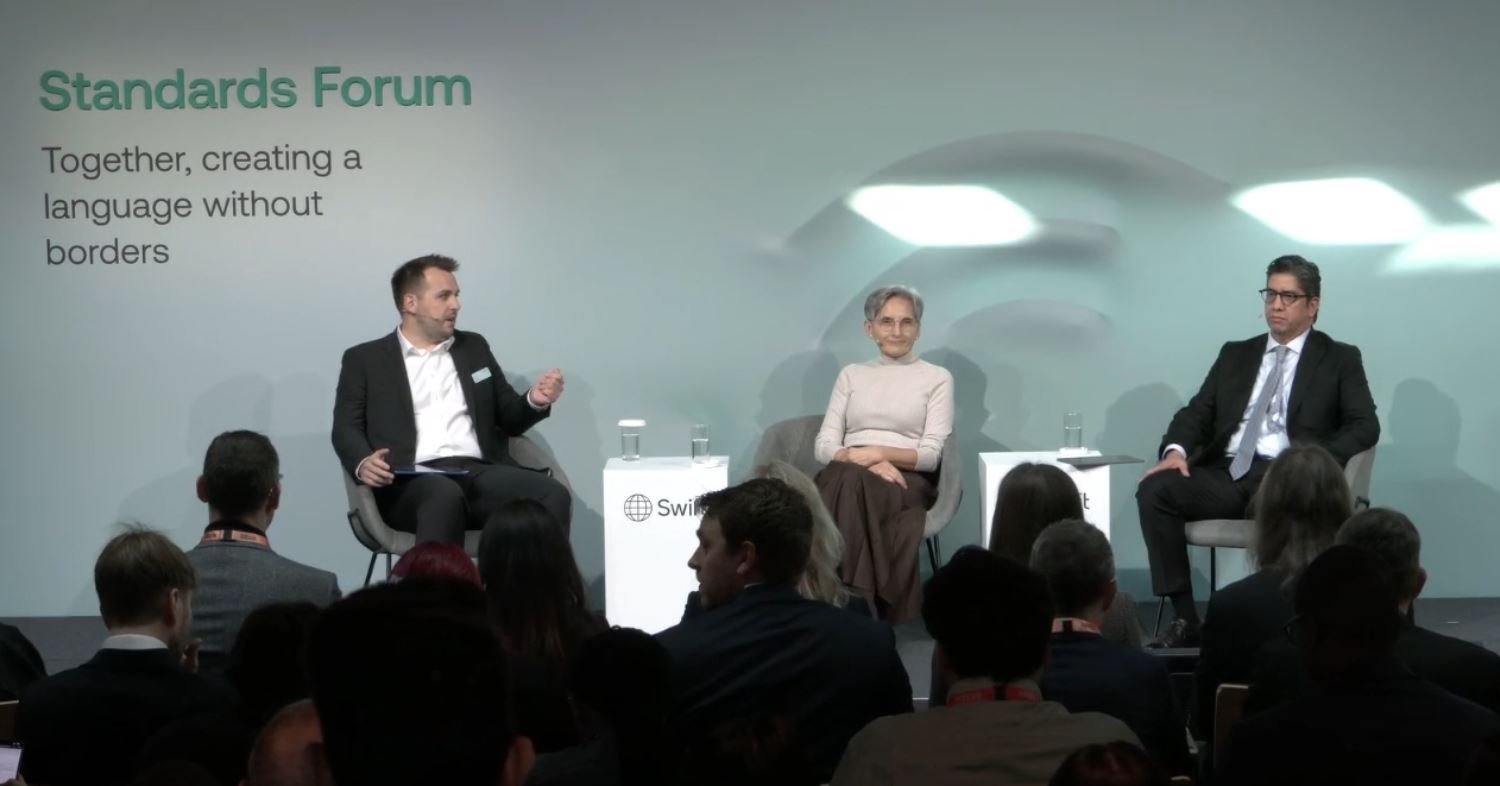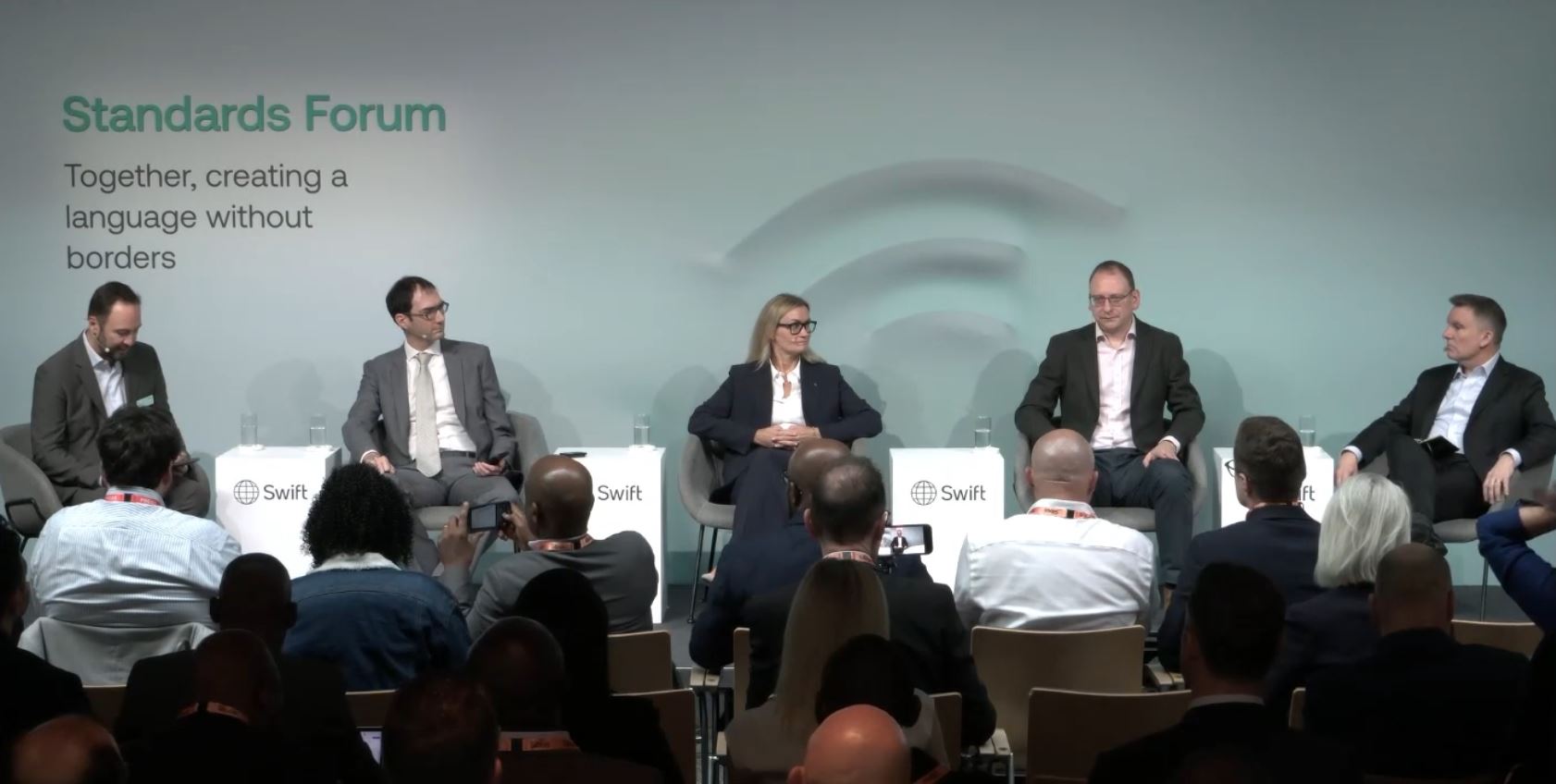21 October 2025
At Sibos 2025 Frankfurt, two clear themes for the payments industry emerged: the need to refresh its foundations and accelerate innovation. In the first of two wrap-ups, flow reports on sessions discussing the balance between a safe financial system and friction-free payments
MINUTES min read
For visitors arriving in Frankfurt, the city’s blend of heritage and innovation is hard to miss. Towering glass skyscrapers are juxtaposed with centuries-old cathedrals – a fitting reflection of a financial centre balancing both legacy and transformation.
As reported in flow’s ‘Building the bank of tomorrow’, Swift CEO Javier Pérez-Tasso stated that staying relevant over many generations “requires evolving the classics, while inventing entirely new icons” (using the analogy of the 1960s fashion item, the Adidas Stan Smith tennis shoe). Essentially, this means “innovating over two parallel tracks – one foot in the past, one in the future – but always remaining one step ahead”.
As applied to payments, that balance captures the situation the industry finds itself in today: making the foundations of today’s payment systems fit for purpose as it embraces the next frontiers of global finance.
Where next on the G20 Roadmap?
In November 2020 – just after the sole online-only Sibos conference to date – G20 members endorsed the Roadmap for Enhancing Cross-border Payments (the Roadmap), setting out quantitative targets to lower costs and increase the speed accessibility and transparency of international payments by the end of 2027.

‘The G20 Grand Prix: Who’s the Real Winner?’ Left to right: Jessica Renier, Managing Director of Digital Finance, Institute of International Finance; Burkhard Balz, Member of the Executive Board, Deutsche Bundesbank; Martin Moloney, Deputy Secretary General, Financial Stability Board (FSB); Rosemary Stone, Chief Corporate Officer, Swift; Peng Yang, CEO Ant International; Melvyn Low, Head of Global Transaction Banking, OCBC
Speaking at the big issue debate – The G20 Grand Prix: Who’s the Real Winner? – Martin Moloney, Secretary General of the Financial Stability Board (FSB), the body responsible for measuring progress, framed these targets more as benchmarks for how a good global cross-border payment system should look. Whether targets or benchmarks, he also conceded that the 2027 deadline would not be met. On 9 October, following Sibos, the FSB published a Roadmap update that opened; “Despite significant progress, efforts have not yet translated into tangible improvements for end-users at the global level”.1
“The inflight time is less than 20% of the overall cross-border journey, with a full 80% spent in the last mile”
The question, then, is what’s hampering progress? From a European perspective, Burkhard Balz, Executive Board Member of the Deutsche Bundesbank, said the region’s experience offers both a lesson and a warning for global payments integration. Despite a high level of harmonisation through SEPA, Europe still faces fragmentation – with national silos and local market practices limiting the full benefits of scale.
That fragmentation, added Moloney, is mirrored globally. “Europe is extremely different from Africa, and Asia is different again,” he said, highlighting the complexity of coordinating across jurisdictions with varying infrastructures, capital controls and compliance regimes.
Rosemary Stone, Chief Corporate Officer at Swift, noted that progress on this front depends on tackling frictions at a local level. While 75% of payments travelling over the Swift network reach beneficiary banks within just 10 minutes, more work is needed at the final stage of a payment’s journey – the last mile.
“There’s really this sort of 80/20 rule when it comes to speed,” she explained. “The inflight time is less than 20% of the overall cross-border journey, with a full 80% spent in the last mile – between when it reaches the beneficiary bank and when it’s been credited in the customer’s account.”
“Clients expect seamless, consistent experiences wherever payments flow”
In response to these challenges, last month Swift published Spotlight on speed: Why the last mile is the longest, a report that analysed 40 markets to identify common bottlenecks and potential remedies.2 The report noted that while standardising and automating regulatory reporting and currency controls have so far received the least attention, they may ultimately have the greatest impact on payment speed.
Beyond speed, these divergences also affect transparency – a theme repeated in other Sibos sessions. In Cooperation and standardisation: Reducing friction in global end-to-end transparency, Rachel Whelan, Deutsche Bank’s APAC & MEA Head of Corporate Cash Management and Global Head of Payments & TFX Product Management, stressed, “Clients expect seamless, consistent experiences wherever payments flow. The network is getting more complex, and we need to interconnect these networks to provide end-to-end transparency.”
Looking ahead, Moloney expects the months ahead to be eventful. “We will spend the next two years pushing hard on implementation, but we also need to prepare for that point when we have to go back to the G20 and have a serious conversation about what comes next.”
ISO 20022: the end of the beginning
As the ISO 20022 countdown continues and the November 2025 end of co-existence milestone approaches, 63.4% of payment instruction traffic over Swift has now transitioned from FIN to ISO 20022 messages. During Key takeaways from the Payments Market Practice Group's Annual Forum, Beth Geller, Co-Chair of the Payments Market Practice Group and Industry Issues Executive at J.P. Morgan, noted that most major banks have clear migration plans covering the bulk of payment volumes, while others will move with the support of Swift’s contingency solution. While the transition is expected to be smooth, the move should be viewed as only the end of the beginning, with attention now shifting to long-term objectives.
One such ambition is ensuring consistent, high-quality data across the transaction lifecycle. Speaking during the Standards Forum session Mastering data quality: the key to unlocking ISO 20022’s full potential, Karyna Hutarovich, Business Product Specialist, Corporate Bank at Deutsche Bank, was frank: “Not all bad data gets rejected, some slips through quietly, lowering performance or triggering downstream issues. That’s why it’s not just an internal optimisation problem – it’s something we need to address collectively.”3 Four key areas of focus to drive data quality are, she said, usage guidelines compliance, data integrity and traceability, interoperability, and performance.
Fostering true interoperability remains one of the biggest challenges, as migration to ISO 20022 is not just a Swift initiative – domestic market infrastructures around the world have also mobilised behind the standard. Swift’s Payment Market Infrastructure and Real-Time Gross Settlement data show that around 80% of volume is already ISO 20022-enabled. Yet up to half of that domestic traffic links to cross-border payments, whether inbound or outbound – meaning that even minor variations in how the standard is implemented can create significant friction and downstream impact.
‘Do central banks see the full picture? Aligning domestic ambitions with global ISO 20022 Interoperability’ Left to right: Tom Dunbar, Business Lead, Standard Products, Swift; Paula Roels Head of Swift and Market Infrastructures, Deutsche Bank; Angel Salazar, Director of Payment Systems and Market Infrastructure Development and Innovation, Bank of Mexico
“We see first-hand how local implementations of ISO 20022 can diverge from international standards – often due to differing local requirements or limited understanding. That divergence creates fragmentation and makes interoperability costly, sometimes requiring manual workarounds,” explained Paula Roels, Head of Swift & Market Infrastructures, Deutsche Bank during Do central banks see the full picture? Aligning domestic ambitions with global ISO 20022 Interoperability. “My call to action to local systems preparing to migrate is this: don’t treat it as a local project. Transparency and early communication are essential – and we need timely access to usage guidelines, timelines, and project scopes.”
As for whether central banks really do “see the full picture,” the answer was in the affirmative. Deutsche Bundesbank President Joachim Nagel’s opening speech on Day 1 articulated the balance that needs to be struck between innovation and trust/guardrails in the financial system. “Central banks will not accept any developments that weaken our ability to implement monetary policy…financial stability must not be endangered,” he stressed. On this ISO 20022 panel, Bank of Mexico’s Angel Salazar made the point that financial stability preservation is similar in payments, and the working forums are valuable opportunities for central banks to listen to the commercial sector and learn from them. “We cannot work in isolation, and we need to understand the sector that will be generating the solutions and making the investments,” he said.
In addition, corporates will be directly affected by the next phase of ISO 20022 implementation. “Their input determines how well the payment will function downstream,” added Hutarovich. “The shift to structured and hybrid addresses by November 2026, for example, will impact corporates – so it’s very important to bring them into the fold, educate them and align all together.”
FATF Recommendation 16: a blueprint for transparency
For years, the so-called ‘travel rule’ – aka FATF Recommendation 16 (R.16) – has underpinned global efforts to make cross-border payments more transparent and secure. Its goal is simple but far-reaching: to ensure consistency of information required in payment messages for building a clearer picture of who is sending and receiving money. It also aims to eliminate fraud and errors impacting customers.4
‘Bridging compliance and innovation: FATF Recommendation 16 and the Role of ISO 20022’ Left to right: Nicolas Stuckens, Head of ISO 20022 Adoption and Data Quality, Swift; Stéphane Mahieu, Head of AML/CFT Policy, ACPR France; Patricia Sullivan, Global Head of Institutional Cash Management at Deutsche Bank; Michael Jones, Director of Payment Operations, Bank of England; Tom Scampion, CEO Global Screening Services
Following extensive consultation, in June 2025 the FATF agreed revisions to R.16 to better reflect new technologies, emerging risks, and the shift to ISO 20022. “The basics remain the same – who is paying who?” explained ACPR France’s Stéphane Mahieu, during the Standards Forum session Bridging compliance and innovation: FATF Recommendation 16 and the Role of ISO 20022. “But the two main changes are around structuring and standardisation.”
First, there is a new requirement to make full use of payment infrastructures’ capabilities to standardise data, with an explicit reference to ISO 20022. Second, the revised guidance promotes greater consistency in identification, narrowing the previous range of options – such as address, date and place of birth, or customer identification number.
“The objective is to enhance identification quality, so parties can be clearly identified as payments move across platforms or into crypto,” said Mahieu. “That helps faster analysis by institutions and law enforcement and reduces false positives if the data is accurate.”
For Deutsche Bank’s Patricia Sullivan, the update is a blueprint for transparency. “Historically there was a tug of war between clients’ need for speed and the bank’s need for data integrity and compliance. With ISO 20022, we can embed compliance requirements into payments via standardised formats and more reliable data – so compliance is embedded, not bolted on. That tension is moving towards a more balanced state.”
The central bank view is that all of this will require robust market guidance and harmonisation. Michael Jones, Director at the Bank of England reflected that if the industry fails to use ISO 20022 as an opportunity to operate in a more structured and aligned way, the result will be further friction where there should be advantages – such as greater straight-through processing, improved customer experience, and enhanced opportunities for data analytics.
The new standard also offers tangible efficiency gains in sanctions screening. “In screening, alert rates of around 10%, and even 5%, are considered good – but almost everything alerted is a false positive,” observed Tom Scampion from Global Screening Services. “Putting structure into previously unstructured data is a game changer. Comparing MT103 to ISO 20022 pacs.008, we’ve seen around 30% lower alert rates out of the box – that’s structure at work.”
The FATF’s long implementation timeline – extending to 2030 – reflects the complexity of global coordination and the need for harmonised adoption of ISO 20022. As the industry moves forward, Sullivan emphasised that accountability for data accuracy will be essential: “Without it, it’s garbage in, garbage out.”
Instant treasury APIs and the end of file-based banking
Treasury teams are under pressure to operate in real time, yet many still rely on fragmented file-based systems – something instant treasury APIs aim to address. Olivia Armstrong, Go-to-Market Manager at Swift, opened The instant treasury APIs: building a global standard for real-time corporate access panel by framing the opportunity.
“Instant treasury APIs are about moving from reactive to strategic – enabling treasurers to manage liquidity and payments in real time through secure, automated connections.” She added that Swift is embedding ISO 20022 data directly into its APIs, ensuring information is captured at the source and remains consistent throughout the payment lifecycle.
Currently piloting Swift’s instant treasury API, Johann Lee, Principal Expert for Treasury and Payment Processes at global pharma giant Merck, noted: “The API landscape today is still highly fragmented and proprietary – and if we want to be enabled for real-time cash management, we need a single, standardised approach.” He pointed to three immediate benefits for corporates: better real-time cash positioning to inform investment decisions, more accurate tracking of payment statuses, and faster end-of-day reconciliation across time zones.
Providing the bank perspective, Kerstin Schoenwitz, Head of ISO 20022 Standardisation for Corporates at Deutsche Bank, explained how the Common Global Implementation Market Practice (CGI-MP) – a Swift-supported initiative that aims to simplify various payment related corporate-to-bank implementations by promoting the wider acceptance of ISO 20022 – has already harmonised corporate-to-bank messaging across more than 50 countries.
In our second payment wrap up – ‘One giant step to payments innovation (Part 2)’ flow reports on how technology is building on these foundations.
Sibos Frankfurt 2025 was held at the Frankfurt Messe, Frankfurt, Germany from 29 September to 2 October 2025
Images © Swift
Sources
1 See fsb.org
2 See swift.com
3 See also the Deutsche Bank white paper Guide to ISO 20022 E&I migration and case orchestration
4 See fatf-gafi.org





